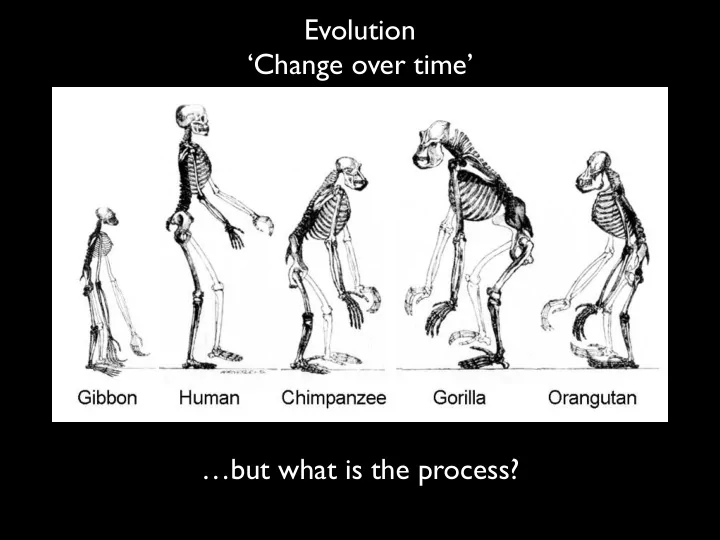

Evolution ‘Change over time’ …but what is the process?
Evolution: Change through time • ‘Unrolling’ • Lamarckian ‘No extinction’
Evolution by Natural Selection Charles Darwin Alfred Russel Wallace
Evolution by Natural Selection! 1. Inheritance 2. Variation 3. Selective ‘force’ Variants don’t have time equal reproductive success Fecundity + Survivorship Fitness
Individuals vs. Populations Populations election => Individuals n => NATURAL EVOLUTION SELECTION
For Section: Modes of Selection Think of examples (not the ones I use) for each e.g. human height e.g. birth weight in humans ~speciation (this is what we will be focusing on) t 1 t 2 t 3
Speciation: Evolution by Natural Selection That is the theory... so what is the evidence?
Evidence for Evolution 1.Homologous characteristics Human Cat Whale Bat related individuals share traits ~variations on the same theme
Evidence for Evolution Homology: The tetrapod body plan
Evidence for Evolution Homologous human limbs ~ dino limbs {The Tetrapod body plan}
Evidence for Evolution Analogous fly wings ≉ pterosaur wings
Evidence for Evolution 2. Vestigial Traits Remnant of the Tetrapod body plan
Evidence for Evolution Vestigial Traits
Evidence for Evolution 3. The Fossil Record 53 Ma 37 Ma 15 Ma
Evidence for Evolution by Natural Selection 3. Modern Evolutionary Events Evolution can occur on much smaller timescales than once thought Finch Radiation Islands: Natural Laboratories 1. Inherited traits (beak size) 2. Variation in trait
Evidence for Evolution by Natural Selection Selection on Galapagos finches As harder seeds became more abundant after a large drought, larger birds (thus larger beaks) were selected for. G. fortis Big Birds Hard Seeds Major Drought Selection 1. Inherited traits (beak size) 2. Variation in trait 3. Selection based on fitness (survival)
Coevolution
Coevolution "I have just received such a Box full from Mr Bateman with the astounding Angræcum sesquipedalia with a nectary a foot long - Good Heavens what insect can suck it?” A. sequipedale
Evidence for Evolution Evolution occurs in many small steps by Natural Selection Over a very long time... Evolution of the eye
Cladograms This is possibly the most important concept for the rest of the course... •A cladogram is a hypothesis of evolutionary relationships •No absolute time... just sequences of events •Parsimony Amphibians Synapsids Therapsids Cephalopods RELATIVE time
Different Hypotheses of Relationships? No! These are all the SAME!
Most Recent Common Ancestor Monophyletic Groups
•Paraphyletic: A group that contains the most recent common ancestor of it’s members, but not all of it’s descendants •Polyphyletic: A group that does NOT contain the common ancestor of it’s members
•Paraphyletic
•Paraphyletic
•Polyphyletic Warm-blooded amniotes
Polytomy ~ unresolved relationship
Some Terms •Shared, derived characteristics = Synapomorphy • Do have splitting, or bifurcation, information •Derived, newly evolved •Non-diagnostic ANCESTRAL traits of a CLADE = Plesiomorphy •Have no ‘splitting’, or bifurcation, information •Ancestral, ‘primitive’
x x • We never expect to find the true common ancestor “If we evolved from x • No such thing as a monkeys, why are there still primitive living ancestor… monkeys?” x Not a progression... a ‘tree’
Parsimony
Parsimony Most parsimonious vs. Mammary glands Hair Wings Live birth Tetrapod body plan 7 evolutionary events 5 evolutionary events
Okay, now put these animals and characters on a PARSIMONIOUS cladogram Species Bird Bear Shark Stegosaurus Deinonychus Characters ‘Bird-Hip’/ Ornithischian condition Loss of Teeth Vertebral Column Tetrapod body plan
The Answer Deinonychus Stegosaurus Bird Bear Shark Loss of Teeth ‘Bird-Hip’/ Ornithischian condition Tetrapod body plan Amniota Vertebral Column Vertebrata DINOSAURIA
Recommend
More recommend